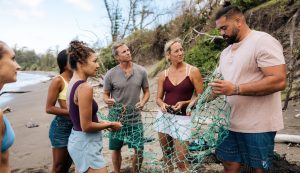Protecting the ‘āina and fighting climate change
Posted on Jan 27, 2022 in Capitol Connection, Featured, MainWe cannot be a strong state without protecting the resources upon which we depend. That is also a part of being pono and making things right. At the heart of these resources is the environment. In Hawai‘i, we’re no strangers to the need to protect the environment. There’s a reverence for the ‘āina that goes beyond issues of sustainability. That’s why we’ve always been so protective of the environment. As an island community, we see the impacts of climate change and global warming more intensely. But by working together, Hawai‘i has become a world leader in actions to fight the climate crisis.
Hawai‘i was the first state to set a goal of 100 percent renewable energy by 2045 with 12 other states following our lead. Hawai‘i was also the first state to commit, by law, to the goals of the Paris Agreement. Hawai‘i became the first state to commit to a net-negative goal by 2045 to capture more carbon than we produce. We’ll do that by protecting our oceans, expanding our native forests and supporting sustainable agriculture. Again, my thanks to our legislators for helping to make all of this happen, but we need to continue this good work. We need to: retire Hawai‘i’s last coal plant, establish a rebate for working families to buy electric cars, expand the State-to-Farm program to support local farmers and move forward with the Royal Kunia Agriculture Park to encourage food self-sufficiency.
Creating a more sustainable lifestyle is all part of being good stewards of these islands. So is protecting them from harm. The recent events at the Navy’s Red Hill facility alarmed and shocked everyone. We’ve met with Navy leaders and let them know that their first job is to ensure that our drinking water stays safe and clean. Draining the fuel tanks at Red Hill is a good first step. But we must work to find long-term solutions. National security cannot come at the expense of our people’s health. I believe we can protect both national security and public health. But it will take determination and the collaborative efforts of everyone.

